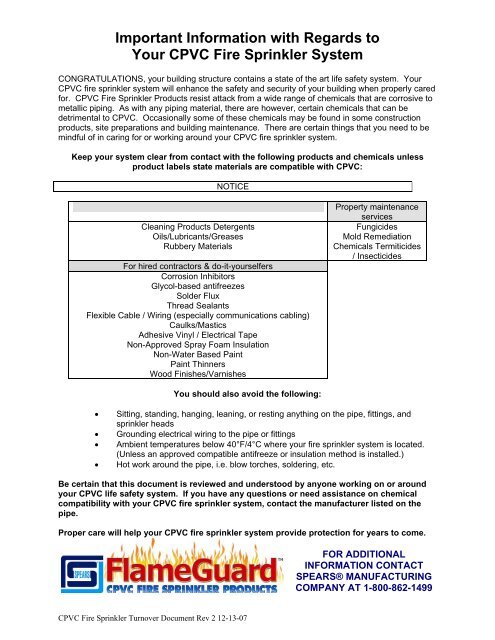Fire Protection Design Manual - Office of Construction and Facilities ...
Fire Protection Design Manual - Office of Construction and Facilities ...
Fire Protection Design Manual - Office of Construction and Facilities ...
You also want an ePaper? Increase the reach of your titles
YUMPU automatically turns print PDFs into web optimized ePapers that Google loves.
Important Information with Regards to<br />
Your CPVC <strong>Fire</strong> Sprinkler System<br />
CONGRATULATIONS, your building structure contains a state <strong>of</strong> the art life safety system. Your<br />
CPVC fire sprinkler system will enhance the safety <strong>and</strong> security <strong>of</strong> your building when properly cared<br />
for. CPVC <strong>Fire</strong> Sprinkler Products resist attack from a wide range <strong>of</strong> chemicals that are corrosive to<br />
metallic piping. As with any piping material, there are however, certain chemicals that can be<br />
detrimental to CPVC. Occasionally some <strong>of</strong> these chemicals may be found in some construction<br />
products, site preparations <strong>and</strong> building maintenance. There are certain things that you need to be<br />
mindful <strong>of</strong> in caring for or working around your CPVC fire sprinkler system.<br />
Keep your system clear from contact with the following products <strong>and</strong> chemicals unless<br />
product labels state materials are compatible with CPVC:<br />
NOTICE<br />
Ordinary considerations<br />
Cleaning Products Detergents<br />
Oils/Lubricants/Greases<br />
Rubbery Materials<br />
For hired contractors & do-it-yourselfers<br />
Corrosion Inhibitors<br />
Glycol-based antifreezes<br />
Solder Flux<br />
Thread Sealants<br />
Flexible Cable / Wiring (especially communications cabling)<br />
Caulks/Mastics<br />
Adhesive Vinyl / Electrical Tape<br />
Non-Approved Spray Foam Insulation<br />
Non-Water Based Paint<br />
Paint Thinners<br />
Wood Finishes/Varnishes<br />
You should also avoid the following:<br />
Property maintenance<br />
services<br />
Fungicides<br />
Mold Remediation<br />
Chemicals Termiticides<br />
/ Insecticides<br />
• Sitting, st<strong>and</strong>ing, hanging, leaning, or resting anything on the pipe, fittings, <strong>and</strong><br />
sprinkler heads<br />
• Grounding electrical wiring to the pipe or fittings<br />
• Ambient temperatures below 40°F/4°C where your fire sprinkler system is located.<br />
(Unless an approved compatible antifreeze or insulation method is installed.)<br />
• Hot work around the pipe, i.e. blow torches, soldering, etc.<br />
Be certain that this document is reviewed <strong>and</strong> understood by anyone working on or around<br />
your CPVC life safety system. If you have any questions or need assistance on chemical<br />
compatibility with your CPVC fire sprinkler system, contact the manufacturer listed on the<br />
pipe.<br />
Proper care will help your CPVC fire sprinkler system provide protection for years to come.<br />
CPVC <strong>Fire</strong> Sprinkler Turnover Document Rev 2 12-13-07<br />
FOR ADDITIONAL<br />
INFORMATION CONTACT<br />
SPEARS® MANUFACTURING<br />
COMPANY AT 1-800-862-1499

















